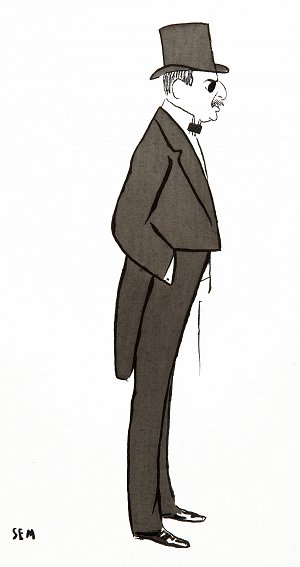Moïse de Camondo, the only son of Nissim de Camondo and Élise Fernandez, was born in Istanbul in 1860. After moving to France with his parents in 1869, he went to school at the Lycée Fontanes (now the Lycée Condorcet) before working for the family bank with his cousin Isaac. At the latter’s death in 1911, Moïse became director. He closed the bank down in 1917.
In October 1891 he married Irène Cahen d’Anvers, daughter of the banker Louis Cahen d’Anvers and of Louise de Morpurgo, who held a famous literary and political salon. Moïse and Irène had two children: Nissim in 1892, and Béatrice two years later. However, their marriage did not last; they separated in 1896 and were divorced in 1901. From 1899 on, Moïse and the children, who were left in his care, lived in a mansion on rue Hamelin in the 16th arrondissement before moving to rue de Monceau in 1913.

Caricature of Moïse de Camondo, by Georges Goursat, aka Sem , c. 1904
© MAD, Paris
Moïse de Camondo was a rather private person, with a rigidity and biting wit that could be intimidating at times. He was a tall, extremely elegant gentleman and a keen sportsman. In his youth he enjoyed yachting and owned a boat called the “Géraldine” in which he cruised the Mediterranean. The nascent automobile industry was his true passion, however; he drove Renaults, Panhards and Bugattis and, accompanied by his chauffeur-mechanic, took part in races such as the Paris-Berlin in 1900. He was also a keen tourist who traveled throughout Europe, sharing his reflections on his travels with the “Club des Cent ” gastronomic association which he joined in 1925.
Moïse was also an excellent horseman. He practised shooting in the environs of Senlis, where he owned a property (the “Villa Béatrice” in Aumont) and hunting in the nearby forest of Halatte. Like the rest of his family, he belonged to the “Par Monts et Vallons ” hunting club.
Above all, however, he was a collector with a passion for the eighteenth century. He particularly admired the elegance that characterized the later years of the reign of Louis XV and flourished in the following reign with the triumph of the neoclassical aesthetic. Shrewdly advised by Carle Dreyfus, a curator at the Musée du Louvre, and Louis Metmann, a curator at the Musée des Arts Décoratifs, Moïse began his personal collection in the late nineteenth century when he lived on rue Hamelin.
His purchases became more frequent with the construction of his new mansion on rue de Monceau, and continued almost until his death. He was a frequent customer of the finest Parisian antique dealers such as Seligmann, Wildenstein, Kraemer, Larcade, Lion and Helft, and also bought at auctions. With patience and determination, he was able to reunite separated pairs of furniture pieces. He sometimes made exchanges too, as his collection was not static but evolved in accordance with his desire to create a perfect eighteenth-century setting. Inspired by the Petit Trianon, the mansion he had built from 1911 onward on rue de Monceau had to be worthy of his collection.

Moïse de Camondo in his first car, 1895
© MAD, Paris
Moïse de Camondo’s later life was overshadowed by the death of his son Nissim, who was killed in an air battle in 1917. The mansion rarely came to life after the war; visitors tended to be close friends and “initiates,” but Moïse still allowed visits from scholars and antique lovers to help them with their studies or research.
Over the years, the priceless splendor of the collection has increased and the rough and tumble of everyday life is now incompatible with the fragility of the furniture and objects – indeed, it would seem incongruous in a place pervaded by Nissim’s memory. By creating the “Nissim de Camondo museum” and devoting his mansion and collection to the memory of his son, Moïse found a way of resisting oblivion. He entrusted its management to the Union Centrale des Arts Décoratifs (which became Les Arts Décoratifs in 2004), of which he had been vice-president since 1930, and the mansion was bequeathed to the state in 1935.
Shortly after the completion of the mansion, World War I broke out. Nissim, who joined up at the outbreak, became a pilot; in 1917, he died for France in aerial combat. Afte his son’s tragic death, Moïse bequeathed his unique collection to Les Arts Décoratifs and to the French state, in Nissim’s memory. Until his death in 1935, Moïse pursued his goal of recreating “an eighteenth-century artistic residence.”
During World War II, Moïse’s daughter Béatrice, her husband Léon Reinach, and their children Fanny and Bertrand died in the Nazi camps.
After their deaths, the Camondo family became extinct.